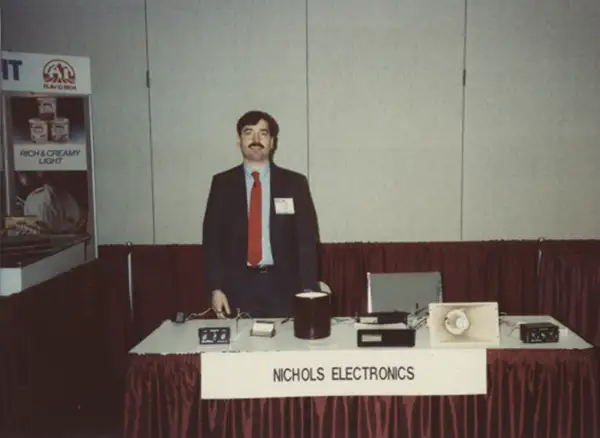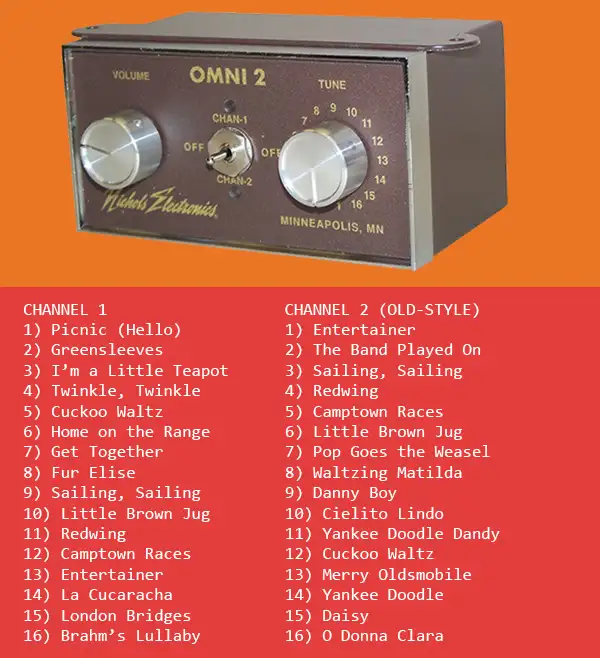In 1973, an electrical engineer named Bob Nichols was watching the film The Sting when a song on the soundtrack — Scott Joplin’s 1902 ragtime hit, “The Entertainer” — caught his ear.
The right clip of that song, Bob realized, would make for an irresistible ice cream truck jingle.
He could imagine trucks gliding through the American suburbs, the tinkling notes summoning children to buy snow cones, sundaes, and bomb pops.
And he was uniquely poised to make it happen: as the founder of Nichols Electronics, a tiny Minnesota-based company, Bob supplied the music boxes — preloaded with dozens of jingles — for the vast majority of the country’s ice cream trucks.
In short order, “The Entertainer” was on Nichols music boxes all over the nation. And 25 years later, it has become the country’s ice cream truck song of choice.
That’s according to Bob’s son, Mark, who now runs Nichols Electronics alongside his wife, Beth. Today, Nichols Electronics no longer controls just the vast majority of the music box market; it is the market.
Mark estimates that the company, which he inherited, is responsible for up to 97% of the music boxes in circulation.
How did ice cream truck music become a thing? And how did one tiny family business secure a stranglehold on the market?
Building a music market from scratch
Ice cream vendors have always relied on music as a marketing tool.
At the end of the 1800s, ice cream pushcart owners sang little verses “in praise of their lemon ice cream and vanilla too” to attract customers, according to the paper “Ding Ding!: The Commodity Aesthetic of Ice Cream Music,” by the ethnomusicologist Daniel T. Neely.
Enjoying this article?
Get the Hustle’s 5-minute weekday roundup that keeps you hip to happenings in tech, business, and internet… things.

Children swarm a Good Humor ice cream truck in the mid-1900s (Getty Images)
In 1920, an Ohio parlor owner named Harry Burt invented the Good Humor bar — the first ice cream treat on a stick — and recruited a team of employees to drive around neighborhoods, selling them out of trucks.
To catch the public’s attention, Burt equipped each truck with a set of bobsled bells that jingled when the vehicle drove by. But ringing a bell all day long soon proved to be too manually taxing for drivers.
Around 1929, some Good Humor drivers started replacing their bells with ad hoc mechanical music boxes.
That shift caught the attention of John Ralston, an ice cream truck driver in Los Angeles.
By the end of the 1940s, Ralston had rigged up his own music box — a complex contraption involving a bunch of microphones hooked up to a vacuum-tube radio — and started pitching it to manufacturers.
When Ralston felt manufacturers were dragging their feet, he turned to his friend, Bob Nichols.

Bob Nichols (far right) with family members in 1972 (Mark Nichols)
Bob had no experience with music boxes.
After founding Nichols Electronics in 1957, the WWII vet set his sights on testing TV and radio parts and manufacturing a few one-off products, like a coin-operated foot massager.
But when Ralston asked him if he could put together an electric music box, Bob decided to give it a go.
They worked out a deal together: Ralston, who was well-connected in the ice cream vending scene, would promote the new music boxes for Bob in exchange for a small cut of profits.
Within just a few years, orders started pouring in from across the country.
Bob never did any print advertising — he didn’t have to. Word spread so quickly in the tight-knit ice cream truck world that ice cream music soon became Bob’s main business.
Convincing ice cream drivers to buy his electronic music boxes wasn’t always smooth sailing.
Bob found himself battling the Bevins Bell Company, which was supplying bells — a much cheaper auditory solution — to most ice cream trucks.
Cities were also wary that the new enthusiasm for music boxes would kick off a scourge of noise pollution. The Abilene, Texas city council became one of many municipalities to debate whether ice cream truck music should be legal at all.

Headlines from the 1950s speak to the negative attention brought on by new ice cream jingles (AP, via Newspapers.com)
But the sales figures made Bob’s case for him. Some industry tests found that ice cream trucks equipped with music boxes sold almost 2x more than ice cream trucks with bells, according to Bob’s son, Mark.
Around 1960, Nichols Electronics upgraded from a disc-based box to a wind-up cylindrical one — a move that sliced down the price of a music box from $125 to $80.
At that point, says Mark, “my father had most of the market.”
Running a niche ice cream business
When Mark was younger, the family business held a special allure.
As a young kid, he’d mess around with circuit boards in his father’s workshop. After graduating college, he completed a multi-year electrical technician program to learn the ins and outs of the trade. And by the early 1980s, he was a full-time employee.
When he took over the business shortly before his father died in 2003, the company was selling 2k music boxes a year.
But today, the number of ice cream trucks on the road has shrunk — and so has the demand for music boxes. These days, the company only produces 300-400 boxes per year.

Mark Nichols at an ice cream vendors convention in the early 1990s (Mark Nichols)
Mark will tell you right off the bat: The reason Nichols Electronics controls the entire ice cream truck music market isn’t that it’s a particularly powerful company.
In earlier decades, Nichols Electronics had several full-time employees, but the company has since shrunk down to just Mark and Beth.
If a resource-rich corporation — say, General Electric — decided to jump into the ice cream truck music game, that corporation very well might succeed. But there’s a reason a larger entity hasn’t tried to dislodge Nichols Electronics as the reigning ice cream music kingpin.
“It’s a very difficult market,” says Mark.
Profits are slim, and selling ice cream truck music boxes requires a lot of time and connections to independent truck owners. Over the years, Mark has witnessed a handful of competitors come and go without success.
But the ice cream truck business has a strange quirk: it typically sees a bump in the wake of a financial meltdown.
COVID-19 has been no exception.
A record unemployment rate coupled with stay-at-home mandates has been good for ice cream trucks: scores of people are signing up to drive them, and sales are booming.
“You have a huge labor force available right at the time people are at home,” says Mark. “It’s the perfect circumstances for a little bit of a revival for the industry.”

The Nichols Electronics workshop in Minnesota (Cecilia Johnson/MPR)
Some of his clients have told him that they’re having their best year since the turn of the century. Mark is feeling the upswing, too.
Nichols Electronics may not be a large corporatized monopoly. But since it controls the music box market, it also has a near-unilateral sway over which songs reverberate through neighborhoods across the country.
The art of choosing an ice cream truck song
If you listen to enough ice cream truck songs, you might start to notice a pattern: they all have the same tinny, high-frequency sound.
Music boxes tend to accentuate the high notes and attenuate the low notes of a song. Because that higher-frequency sound is so rare today, we immediately associate it with ice cream.
Ice cream truck songs tend to follow a few rules:
- They’re short and easy to remember: Mark pegs the perfect length at between 15 and 45 seconds.
- They’re structurally simple: “You don’t want the music to be very full,” music historian Daniel T. Neely tells us. “If it’s too complicated, the message becomes kind of muddled.”
- They’re typically rooted in nostalgia.
That last point is perhaps the most crucial element of a good ice cream truck song: We’re drawn to these melodies because we’ve heard them before. Many of the biggest hits, including “The Entertainer,” had a place in our culture long before ice cream trucks started pumping them out.
Nichols’ current music box — called the Omni 2 ($225) — comes preloaded with 32 songs, all in the public domain.

The 32 songs on the company’s best-selling music box, the Omni 2, (Nichols Electronics)
The tracklist looks almost exactly as it did in the ‘70s, and Mark and Beth make a point not to fuss with it much. The main reason for this is that a truly new ice cream truck song is hard to get off the ground.
Recently, though, one of the tracks included on Nichols’ music box was called in question.
Music scholars discovered that the popular ice cream truck melody, “Turkey in the Straw,” appeared in a racist 1916 song. This spring, as protests spread across the country, Mark decided to pull it from his music box.
“We don’t want a single child walking away from the ice cream truck feeling bad because of the song they were hearing,” he says.
He’s replacing it with a new 45-second jingle written and produced by Wu-Tang Clan member, RZA, which blends “traditional ice cream truck sounds with jazz and hip-hop elements.”

RZA, of Wu-Tang Clan fame, recently mixed up his own ice cream truck song (Good Humor)
There’s some skepticism in the ice cream truck industry that a new track will work out as a sales tool.
“People [always] think they’re going to come up with the next successful ice cream vending song,” says Mark, “and they almost always fail.”
The main reason: the public simply hasn’t had time to formulate an internal association between the song and ice cream. Otherwise, “the consumer thinks it’s just some kid playing his boombox too loud.”
Neely says that it’s too late in the summer for us to measure the new song’s success. But by next August, we’ll have a better sense of whether RZA’s track will hold up.
He’s off to a good start: his song is already set to appear on Nichols music boxes, which is the best — and maybe only — way to enter the ice cream truck musical canon.
Get the 5-minute roundup you’ll actually read in your inbox
Business and tech news in 5 minutes or less









